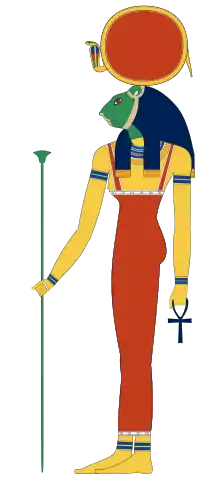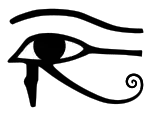Sekhmet
In Egyptian mythology, Sekhmet (/ˈsɛkˌmɛt/[1] or Sachmis (/ˈsækmɪs/), also spelled Sakhmet, Sekhet, Sakhet among other spellings, Coptic: Ⲥⲁⲭⲙⲓ, romanized: Saxmi), is a warrior goddess as well as goddess of healing. She is depicted as a lioness. She was seen as the protector of the pharaohs and led them in warfare. Upon death, Sekhmet continued to protect them, bearing them to the afterlife.
| Sekhmet | |||||
|---|---|---|---|---|---|
 Sekhmet with head of lioness and a solar disk/sun disk and uraeus on her head | |||||
| Name in hieroglyphs | |||||
| Major cult center | Memphis, Leontopolis | ||||
| Symbol | Sun disk, red linen, lioness | ||||
| Parents | Ra | ||||
| Consort | Ptah | ||||
| Offspring | Nefertem | ||||
Sekhmet is a solar deity, sometimes called the daughter of Ra and often associated with the goddesses Hathor and Bastet. She bears the Uraeus, which associates her with Wadjet and royalty, and the solar disk.
Roles
| Part of a series on |
| Ancient Egyptian religion |
|---|
 |
|
|
Sekhmet was the daughter of the sun god, Ra, and was among the more important of the goddesses who acted as the vengeful manifestation of Ra's power, the Eye of Ra. Sekhmet was said to breathe fire, and the hot winds of the desert were likened to her breath. She was also believed to cause plagues (which were called as her servants or messengers) although she was also called upon to ward off disease.[2]
In a myth about the end of Ra's rule on the earth, Ra sends the goddess Hathor, in the form of Sekhmet, to destroy mortals who conspired against him. In the myth, Sekhmet's blood-lust was not quenched at the end of battle that led to her destroying almost all of humanity. To stop her Ra poured out beer dyed with red ochre or hematite so that it resembled blood. Mistaking the beer for blood, she became so drunk that she gave up the slaughter and returned peacefully to Ra.[3] The same myth was also described in the prognosis texts of the Calendar of Lucky and Unlucky Days of papyrus Cairo 86637.[4]
In other versions of this story, Sekhmet grew angered at the deception and left Egypt, diminishing the power of the sun. This threatened the power and security of the world—thus, she was persuaded by the god Thoth to return and restore the sun to its full glory.[5]
Sekhmet was considered the wife of the god Ptah and mother of his son Nefertum. She was also said to be the mother of a lion god, Maahes. She was also considered to be the sister of the cat goddess Bastet.[6][7]
Worship
During an annual festival held at the beginning of the year, a festival of intoxication, the Egyptians danced and played music to soothe the wildness of the goddess and drank great quantities of wine ritually to imitate the extreme drunkenness that stopped the wrath of the goddess—when she almost destroyed humanity.
In 2006, Betsy Bryan, an archaeologist with Johns Hopkins University excavating at the temple of Mut in Luxor (Thebes) presented her findings about the festival that included illustrations of the priestesses being served to excess and its adverse effects on them being ministered to by temple attendants.[8] Participation in the festival was great, including by the priestesses and the population. Historical records of tens of thousands attending the festival exist. These findings were made in the temple of Mut because when Thebes rose to greater prominence Mut absorbed some characteristics of Sekhmet. These temple excavations at Luxor discovered a "porch of drunkenness" built onto the temple by the Pharaoh Hatshepsut during the height of her twenty-year reign.
During the Greek dominance in Egypt, note was made of a temple for Maahes that was an auxiliary facility to a large temple to Sekhmet at Taremu in the Delta region, a city which the Greeks called Leontopolis.
In popular culture
Sekhmet appears in the Marvel Cinematic Universe (MCU) film Thor: Love and Thunder. She appears seated in Omnipotence City of the gods, where all major deities are located, during an announcement from leader of the gods, Zeus.
In The Kane Chronicles books written by American author Rick Riordan Sekhmet is described as a 'golden woman' in glowing red armor, with the head of a lioness, and with the sun floating above her head.
Sekhmet appears in the action role playing video game Assassin's Creed Origins. Sekhmet is the result of Layla Hussan exploring the memories of Bayek of Siwa in the portable Animus HR-8.
In the real time strategy video game Age of Mythology Sekhmet is an Egyptian Heroic Age minor god. In the game she is available to worshipers of Set and Ra.
In Legendary Pictures MonsterVerse Sekhmet is a giant lion-like Kaiju. She is briefly seen as an ancient carving.
The Creepshow episode "Okay I'll Bite" has Elmer Strick, the protagonist, call on Sekhmet for vengeance while in prison, believing she held the secret of eternal life in ancient Egypt. There she is identified as granting worshipers revenge, and having an association with spiders.
See also
- List of solar deities
- List of war deities
- List of health deities
- Lion
References
- "Sekhmet". Dictionary.com. Random House. 2012.
- Wilkinson, Richard H. (2003). The Complete Gods and Goddesses of Ancient Egypt. Thames & Hudson. p. 181.
- Lichtheim, Miriam (2006) [1976]. Ancient Egyptian Literature, Volume Two: The New Kingdom. University of California Press. pp. 197–199.
- Jetsu, L.; Porceddu, S. (2015). "Shifting Milestones of Natural Sciences: The Ancient Egyptian Discovery of Algol's Period Confirmed". PLOS ONE. 10 (12): e.0144140 (23pp). arXiv:1601.06990. Bibcode:2015PLoSO..1044140J. doi:10.1371/journal.pone.0144140. PMC 4683080. PMID 26679699.
- Strudwick, Helen (2006). The Encyclopedia of Ancient Egypt. New York: Sterling Publishing Co., Inc. p. 135. ISBN 978-1-4351-4654-9.
- "Bastet".
- Wilkinson, Richard H. (2003). The Complete Gods and Goddesses of Ancient Egypt. Thames & Hudson. pp. 178, 181.
- "Sex and booze figured in Egyptian rites", archaeologists find evidence for ancient version of ‘Girls Gone Wild’. From NBC News, 30 October 2006
Bibliography
- Germond, Philippe (1981). Sekhmet et la protection du monde (in French). Editions de Belles-Lettres.
- Hoenes, Sigrid-Eike (1978). Untersuchungen zu Wesen und Kult der Göttin Sachmet (in German). R. Habelt Verlag.
- von Känel, Frédérique (1984). Les prêtres-ouâb de Sekhmet et les conjurateurs de Serket (in French). Presses Universitaires de France.
External links
- Ancient Egypt: the Mythology - Sekhmet
- "Egyptian Temple Yields 17 Statues of Lion-Headed Goddess" Archaeologists working in Luxor, Egypt, have unearthed 17 statues of an ancient Egyptian goddess with the head of a lion and the body of a woman. 14 March 2006
